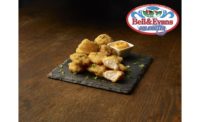Premium poultry brand Bell & Evans has withstood the test of time. Current owner Scott Sechler has spent the last 35 years transforming the way poultry is produced in America and escalating Bell & Evans to new heights, but there’s a rich history behind the brand that spans 125 years and several generations of poultrymen. Read how humble beginnings in poultry dealing and a passion for selling only premium birds led two men from New Jersey to establish the renowned Bell & Evans, and learn how Fredericksburg, Pennsylvania became home to the beloved brand.
Bell & Evans was named after founding partners Howard Hughes Bell of Bellmawr, New Jersey, and Carlton Sharp Evans of Moorestown, New Jersey. Bell was born in 1861 on his family’s 225-acre farm on Browning Road where his father, James, was raised and where his grandfather, Hughes, had settled in 1826. The Bells were a well-respected fruit producer, especially known for shipping premium quality peaches all over the country. They were also inventors, creating and improving farm machinery to reduce labor and horses in the fields. One of Howard’s sons, Ernest C. Bell, went on to become a well-known horse breeder, the town of Bellmawr named after him. His other son, Arthur, followed in Howard’s footsteps as a poultryman.
In a letter dated April 12, 1997, from Howard Bell’s granddaughter Jean Bell Landis to Scott Sechler, Landis wrote “…my grandfather, Howard H. Bell, was in the squab business here at the Bellmawr farm. He had been dealing with a Carlton Evans in the poultry business and they formed a partnership of Bell & Evans.” She added, “Howard Bell was married in the early 1890s, and I would have to put the date for the start of Bell & Evans around that time.” News records show that Howard Bell married Sarah Matlack in 1894, the anniversary year Bell & Evans celebrates as its beginning.
Newspaper clippings from the early 1900s show that Bell was producing and shipping poultry by rail to New York City. The Evans were a farm family located about thirteen miles from the Bell farm. News records indicate that Carlton Evans joined Bell in business in 1910. Ten years later, Evans built a large storage plant on his property to accommodate their growing poultry business, and in 1926, the partners opened their first poultry plant on 27th Street in Camden, New Jersey. Bell & Evans was officially incorporated in 1927.
In 1934, a fire swept through the Bell & Evans warehouse causing $50,000 of damage, killing more than 10,000 live birds and destroying thousands of dollars’ worth of dressed product. A few months later, Bell & Evans moved to a new, larger space on 16th and Mickle streets in Camden. Howard Bell passed away a couple years later and his son Arthur continued the partnership with Evans.
Throughout the ‘30s, Bell & Evans sold premium dressed and live turkeys, capons, guinea hens, squabs and chickens from their network of thousands of farm partners throughout New Jersey, Maryland, Delaware and beyond. Evans was quoted in the December 12, 1935, The Morning Post (Camden, New Jersey) article “No Shortage of Fowl Here” as saying: “We travel constantly studying the flocks and making our selection. The result is that we have poultry engaged ahead of seasons of heavy demand such as the present…We have bought for so long and paid such fair prices that we have the pick of the flocks in these three states.”
Quality has always been top priority for Bell & Evans. In the December 21, 1938, The Morning Post article “Poultry Firm Here in Seasonal Rush,” the author wrote: “The famous Philadelphia capon served by the city’s leading hostelries are supplied by Bell & Evans. Hotels and many New York dining places are on the company’s list of customers. The company has chosen to preserve its reputation for quality rather than specialize in low price poultry. No effort is made, it is explained, to supply the demands of low-price chain markets.”
Bell & Evans concentrated sales to the finest hotels, restaurants, entertainment venues and butcher shops in New York, Philadelphia, South Jersey and beyond. They would often ship as many as 5,000 birds a day. By the 1950s, demand for Bell & Evans had grown so much that the firm had trouble keeping up with dressed production. That’s when they realized a change was needed, and a partnership emerged with Clarence F. Manbeck in Fredericksburg, Pennsylvania, the small, rural town that is home to present day Bell & Evans.
Manbeck grew up in the poultry business. Both his father and grandfather were poultrymen. In 1939, Manbeck purchased a small 20’ x 20’ poultry processing plant from Wilson H. Degler in Fredericksburg, Pennsylvania, and soon after partnered with another local poultryman, John Kissinger, previous manager of neighboring College Hill poultry plant in Fredericksburg. When Manbeck purchased the business from Degler, it had five employees and sold poultry at local markets throughout Lebanon, Schuylkill, Montgomery and Berks counties. Manbeck and Kissinger continued to expand the business and became two of the original pioneers of cut-up poultry merchandising.
The poultry business became complicated during WWII because the War Food Administration diverted most of Manbeck’s chicken to 18 hospitals throughout the Philadelphia area and enforced rules against processors like preventing the transportation and sale of eviscerated chicken to civilians. “Cleaned” chicken was to be reserved for the troops, which was an effort to decrease the demand of chicken from the public.
As the war ended, chicken demand skyrocketed, and business bloomed. Manbeck and Kissinger acquired several local poultry businesses including Manbeck’s own father’s business. To handle distribution, the operation split into two firms – C. F. Manbeck, Inc. as the production leg and Farmer’s Pride, Inc. as the sales organization. The partners began opening retail outlets to sell their chicken and operated their own airport beside the plant where day-old baby chicks were delivered from distant farms and raised on three business-owned broiler farms. By 1948, the business was processing 2.5 million broilers a year.
In 1955, Kissinger transferred his ownership back to Manbeck, stepping away from the business for health reasons. Farmer’s Pride had 38 retail stores in Pennsylvania, Ohio, New York and Delaware and processed 10,000 – 14,000 chickens a day, five days a week, and between 700 – 1,000 turkeys each week. They also collected and sold approximately 25,000 eggs from Lebanon county farms in its stores each week. The business incorporated in 1956, and it was then that Manbeck received a call from Bell & Evans. Bell & Evans lacked the necessary processing space and equipment to meet demand and Manbeck’s facility had the ability to process Bell & Evans poultry following its stringent specifications. A percentage of Bell & Evans production moved to Manbeck’s processing plant.
WWII would prove not to be the only obstacle Manbeck faced. In 1973, President Nixon froze meat prices for 60 days, yet the price of grain and feed continued to increase. Some farmers refused to raise chickens during that time. A decade later, a recession brought additional hardships that led Manbeck to furlough 75 production workers and cut back to 66% capacity in the plant.
Despite challenges, Manbeck continued to lead a successful business, and the year 1981 brought a win for the processor and Bell & Evans brand. In the March 4, 1981, issue of the New York Times, Bell & Evans chicken beat out 12 other brands in a taste test, the only one to receive an “Excellent” rating. To this day, Bell & Evans is known as The Excellent Chicken.
In late 1983, Manbeck was ready to retire and, with no family interested in taking over the business, he put the companies up for sale. A cooperative of local chicken growers from the Pennsylvania Farmers Association attempted to purchase the business to replace business they lost when nearby Mandata Poultry Co. filed for bankruptcy earlier that year, but the group failed to secure an offer. Manbeck had another potential buyer, Scott Sechler, age 24, of Sechler Poultry, Inc.
Scott Sechler grew up on a farm and began raising flocks of chickens at a very young age. Poultry has always been his passion. As a child, he paid close attention to every detail of the process and questioned every practice, always concerned with animal welfare and raising healthy birds. He knew as a kid that the secret to producing quality chicken was to raise the birds right, with low stress, in a clean house, and without the need for antibiotics. That was an insight that would later lead Bell & Evans to become the first poultry producer to eliminate the use of antibiotics in 1998 for 100% of its broilers.
By age 14, Sechler was riding along in trailers, taking loads of poultry into Canada where there was a great demand for chicken. He learned a lot from the many poultrymen he grew up around. At 16, Sechler purchased his first truck to haul his own loads of chickens into Canada. After high school, his father put him in charge of the family business, Sechler Poultry, Inc.
For Sechler to purchase Manbeck’s companies in 1983, he had to take out a sizeable loan. Interest rates were at 19% prime plus 4.5%. In addition to the substantial financial risk, shortly after Sechler purchased the poultry businesses in 1984, an 11-month avian flu quarantine went into effect, prohibiting him from selling birds in Canada, his prime target market. Despite this obstacle, he doubled production and jobs within the first two months as owner, expanding Manbeck’s existing U.S. business.
Sechler now had the means to implement his ideas on a larger scale, and he immediately prepared for the removal of antibiotics which he always believed were a crutch for poor practices. By 1985, Sechler required chicken houses have cement floors and curbs to prevent pests and rodents from entering and to allow for a thorough cleanout between flocks. He also required fresh litter for new flocks. These efforts are to break the lifecycle and limit the growth of bacteria in houses, instrumental to removing antibiotics. To this day, these practices continue in all Bell & Evans chicken houses.
In 1986, the retiring Bell family offered Sechler the opportunity to purchase the Bell & Evans brand. He seized the opportunity and coupled his businesses together, choosing to produce 100% of his chicken to the premium-grade Bell & Evans quality.
Sechler’s intentions have always been to produce superior quality chicken while promoting honest and humane animal welfare practices. He pioneered the natural chicken movement with his all-vegetarian feed, using only U.S. grown corn and extruded and expeller-pressed soybean and through the elimination of antibiotics. He also established the most comprehensive set of Humane Animal Welfare Standards in the industry, including introduction of Slow Induction Anesthesia in 2011 and the World’s First Organic Certified, Animal-Welfare-Focused Chicken Hatchery in 2017.
Sechler continues to innovate every step of the way with new equipment, processes and products. Bell & Evans is still the only processor to use 100% Air Chill on 100% of its birds since 2005, a difference you can taste and see in the quality of the meat. Sechler’s honest and immense passion for producing the most superior quality chicken money can buy has catapulted the tried-and-true poultry brand of Bell & Evans into the most trusted chicken brand in America. Scott Jr. and Margo, Sechler’s children, also grew up in the family business and share Scott’s same passion for humanely raised, premium chicken. Scott Jr. and Margo will follow in their father’s footsteps as Bell & Evans’ next generation of leaders.
No other poultry brand in America shares the longevity and dedicated poultry focus as Bell & Evans, a brand built and led by generations of experienced poultrymen with an honest and unyielding commitment to quality.
Source: Bell & Evans





